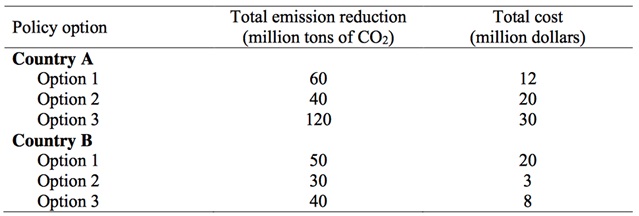Assignment:
Question 1
Suppose that there are two coal power plants, and air pollution is generated as a by- product of energy production. Assume that each plant can control the level of their emissions at the following marginal abatement costs:
MAC1 =20-10q1 MAC2 =10-2.5q2
where qi is the amount of emissions produced by plant i (i = 1,2). Given the individual marginal abatement costs, the aggregate abatement cost is MAC = 12 - 2q where q is the total amount of emissions; that is, q = q1 + q2. The marginal pollution damage is constant at MD = 4.
a Draw a diagram illustrating the aggregate marginal abatement cost curve and the marginal pollution damage curve.
b Calculate the aggregate level of emissions when there is no pollution control.What is the level of emissions produced by each plant?
c Calculate the socially optimal aggregate level of emissions. How much emissions should each plant reduce to achieve this level?
d Suppose that a uniform emission standard is chosen to reduce the emissions to the efficient level found in part c. Why do you think that this is, or is not, an effective way to control the emissions? Draw a diagram to help explain your reasoning.
e. Suppose that an emission charge system is chosen to reduce the emissions to the efficient level found in part c. How will this affect each plant's behaviour? Draw a diagram to help explain your reasoning.
f. Discuss whether you agree or disagree with the following statement.
"When the control authority does not have knowledge of the marginal damage, the control authority can still calculate the required rate of tax to achieve a target level that the control authority wishes."
Question 2:
Suppose that there are two countries (A and B), and the terms of an international agreement require reduction of Country A's CO2 emissions by 200 million tons, and those of Country B's emissions by 50 million tons. The table below summarises theemissions reduction policy options for each country, and their cost:

Assume that any of the policy options can be partially implemented at a constant marginal cost. For example, Country A can choose to reduce CO2 emissions with Option 1 by 10 million tons at a cost of $2 million.
a. If the two countries operate independently, how much CO2 emissions will be reduced using each option? Use a diagram to explain your reasoning.
b.Suppose that a market of transferable emission permits is created, so that it allows Countries A and B to trade permits to achieve the overall emission reduction target of 250 million tons. Who has an interest in buying permits? Who has an interest in selling permits? What is the range for the permit price both countries agree to trade their permits? Use a diagram to explain your reasoning.
c. If all permits are initially allocated to Country A, will your result in part b change? Discuss.
Question 3
1. How would each of the following affect the Faustmann rotation interval for trees? Explain whether the rotation interval increase or decrease. Explain your reasoning.
1. i) An increase in planting costs
2. ii) An increase in discount rate
3. iii) an increase in the productivity of agricultural land
c Explain two potential problems involved in using the travel cost method (TCM) to value a recreational site.
Question 4
Define public goods. Use the conservation of biodiversity, as an example of a public good, to explain why the provision of public goods is often subject to market failures.
Question 5
Use an example to explain the difference between flow and stock pollutants.
Question 6
How would each of the following affect the dynamically efficient resource allocation?
Draw a diagram to explain your results.
1. i An increase in the discount rate.
2. ii An increase in the total supply of the resource.
Question 7
a) Do you agree or disagree with the following statement? Explain your reasons.
"The establishment of no-take marine reserves is an effective way to eliminate the race-to-fish incentives because all forms of fishing are prohibited within the reserves."
b) Suppose that there are two fishing nations and that they share a common fish stock. Explain why it is often difficult to establish an agreement between them to catch fish cooperatively, when there is no external authority.